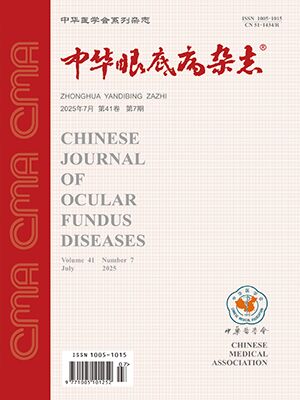| 1. |
Finkelstein D. Ischemic macular edema. Recognition and favorable natural history in branch vein occlusion[J]. Arch Ophthalmol, 1992, 110(10): 1427-1434. DOI: 10.1001/archopht.1992.01080220089028.
|
| 2. |
Higashiyama T, Sawada O, Kakinoki M, et al. Prospective comparisons of intravitreal injections of triamcinolone acetonide and bevacizumab for macular oedema due to branch retinal vein occlusion[J]. Acta Ophthalmol, 2013, 91(4): 318-324. DOI: 10.1111/j.1755-3768.2011.02298.x.
|
| 3. |
Yoo JH, Ahn J, Oh J, et al. Risk factors of recurrence of macular oedema associated with branch retinal vein occlusion after intravitreal bevacizumab injection[J]. Br J Ophthalmol, 2017, 101(10): 1334-1339. DOI: 10.1136/bjophthalmol-2016-309749.
|
| 4. |
Tilgner E, Dalcegio Favretto M, Tuisl M, et al. Macular cystic changes as predictive factor for the recurrence of macular oedema in branch retinal vein occlusion[J/OL]. Acta Ophthalmol, 2017, 95(7): e592-e596[2017-11-01]. https://pubmed.ncbi.nlm.nih.gov/28266152/. DOI: 10.1111/aos.13396.
|
| 5. |
Suzuki M, Nagai N, Minami S, et al. Predicting recurrences of macular edema due to branch retinal vein occlusion during anti-vascular endothelial growth factor therapy[J]. Graefe's Arch Clin Exp Ophthalmol, 2020, 258(1): 49-56. DOI: 10.1007/s00417-019-04495-9.
|
| 6. |
Hayreh SS. Occlusion of the central retinal vessels[J]. Br J Ophthalmol, 1965, 49(12): 626-645. DOI:10.1136/bjo.49.12.626.
|
| 7. |
Rosenfeld PJ, Durbin MK, Roisman L, et al. ZEISS Angioplex™ spectral domain optical coherence tomography angiography: technical aspects[J]. Dev Ophthalmol, 2016, 56: 18-29. DOI: 10.1159/000442773.
|
| 8. |
Coscas F, Glacet-Bernard A, Miere A, et al. Optical coherence tomography angiography in retinal vein occlusion: evaluation of superficial and deep capillary plexa[J]. Am J Ophthalmol, 2016, 161: 160-171. DOI: 10.1016/j.ajo.2015.10.008.
|
| 9. |
Kim KM, Lee MW, Lim HB, et al. Repeatability of measuring the vessel density in patients with retinal vein occlusion: an optical coherence tomography angiography study[J/OL]. PLoS One, 2020, 15(6): e0234933[2020-06-25]. https://pubmed.ncbi.nlm.nih.gov/32584907/. DOI: 10.1371/journal.pone.0234933.
|
| 10. |
Coscas F, Sellam A, Glacet-Bernard A, et al. Normative data for vascular density in superficial and deep capillary plexuses of healthy adults assessed by optical coherence tomography angiography[J]. Invest Ophthalmol Vis Sci, 2016, 57(9): 211-223. DOI: 10.1167/iovs.15-18793.
|
| 11. |
Adhi M, Filho MA, Louzada RN, et al. Retinal capillary network and foveal avascular zone in eyes with vein occlusion and fellow eyes analyzed with optical coherence tomography angiography[J]. Invest Ophthalmol Vis Sci, 2016, 57(9): 486-494. DOI: 10.1167/iovs.15-18907.
|
| 12. |
邢怡桥, 刘芳, 李拓. 缺血型与非缺血型视网膜分支静脉阻塞患者黄斑区血流对比[J]. 眼科新进展, 2019, 39(11): 1036-1039. DOI: 10.13389/j.cnki.rao.2019.0237.Xing YQ, Lu F, Li T. Observation of the macular vessels in ischemic and non-ischemic branch retinal vein occlusion using optical coherence tomography angiography[J]. Rec Adv Ophthalmol, 2019, 39(11): 1036-1039. DOI: 10.13389/j.cnki.rao.2019.0237.
|
| 13. |
Seknazi D, Coscas F, Sellam A, et al. Optical coherence tomography angiography in retinal vein occlusion: correlations between macular vascular density, visual acuity, and peripheral nonperfusion area on fluorescein angiography[J]. Retina, 2018, 38(8): 1562-1570. DOI: 10.1097/IAE.0000000000001737.
|
| 14. |
安伟婷, 赵琦, 于荣国, 等. 光相干断层扫描血管成像鉴别缺血型与非缺血型视网膜分支静脉阻塞[J]. 中华眼底病杂志, 2021, 37(12): 926-931. DOI: 10.3760/cma.j.cn511434-20210510-00241.An WT, Zhao Q, Yu RG, et al. The role of optical coherence tomography angiography to distinguish ischemic and non-ischemic branch retinal vein occlusion[J]. Chin J Ocul Fundus Dis, 2021, 37(12): 926-931. DOI: 10.3760/cma.j.cn511434-20210510-00241.
|
| 15. |
Moussa M, Leila M, Bessa AS, et al. Grading of macular perfusion in retinal vein occlusion using en-face swept-source optical coherence tomography angiography: a retrospective observational case series[J]. BMC Ophthalmol, 2019, 19(1): 127. DOI: 10.1186/s12886-019-1134-x.
|




